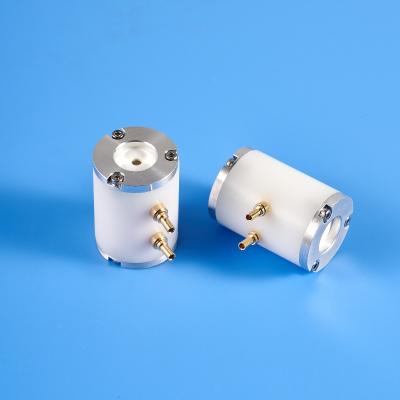High-Power Mid-Infrared Ultrafast Sources at 2 - 5μm Based on Dual-Wavelength Source - Part 9
3 Difference frequency generation of high-power mid-infrared ultrafast light sources
3.3 Differential frequency generation of 2-5 μm high-power tunable mid-infrared ultrashort pulses
To obtain a 2-5 μm high-power tunable mid-infrared ultrashort pulse, a 1.55 μm high-energy ultrashort pulse is used to broaden the spectrum to 1.3-1.9 μm via a SESS (Sequencing Energy Sequencing System) and replaces the signal light in Figure 7(a) in the difference frequency generation system. All components of the difference frequency system are identical to those in Figure 7(a). Adjusting the input pulse energy of the SESS allows the signal light spectrum to be tuned from 1.3-1.9 μm, and laterally moving the PPLN crystal (www.wisoptic.com) matches the polarization period with the wavelengths of the pump and signal lights. Figure 11 shows the spectrum and power corresponding to a pump power of 15 W. The highest power is located at an idler wavelength of 3.28 μm (corresponding to a signal wavelength of 1.5 μm), with an average output power of 1.87 W and a single pulse energy of 56 nJ. As the idler wavelength increases, its average output power decreases, with an average power of 1.02 W at a center wavelength of 4.8 μm. Obvious carbon dioxide and water absorption peaks are observed in the spectra at wavelengths of 4.2 μm and 2.7 μm. The spectral peaks at 2.7 μm and 2.25 μm are the result of the difference frequency generation of the pump light and the signal light at 1.65 μm and 1.9 μm, respectively. Due to the lack of a bandpass filter to separate these two signal light components, the idler frequencies of both bands are simultaneously output to the power meter. Adjusting the PPLN (www.wisoptic.com) polarization period to achieve quasi-phase matching in one band can suppress the generation efficiency of the other spectral component, but the effect is limited. The final output power is 1.1 W, which includes the total power of both spectral peaks. The pump light pulse power was increased to 30 W, and frequency difference was used with signal pulses with center wavelengths of 1.35 μm, 1.4 μm, 1.45 μm, 1.55 μm, and 1.6 μm to obtain idler light with wavelengths of 4.2 μm, 3.9 μm, 3.58 μm, 3.06 μm, and 2.9 μm, respectively, with powers of 1.98 W, 2.48 W, 2.73 W, 2.58 W, and 3.02 W. When the signal wavelength was tuned to 1.3 μm, the SESS generated a wider spectral sidelobe bandwidth. Using the same 50 nm bandpass filter, the frequency bandwidth corresponding to the shorter center wavelength of 1.3 μm was even wider, resulting in a narrower pulse width. After amplification by the DFG process, the peak power was higher, causing the pulse to self-focus in the crystal, ultimately damaging the crystal.

Fig.11. Output spectrum and power of the 2-5μm high power tunable short-wave mid-infrared
laser source.



